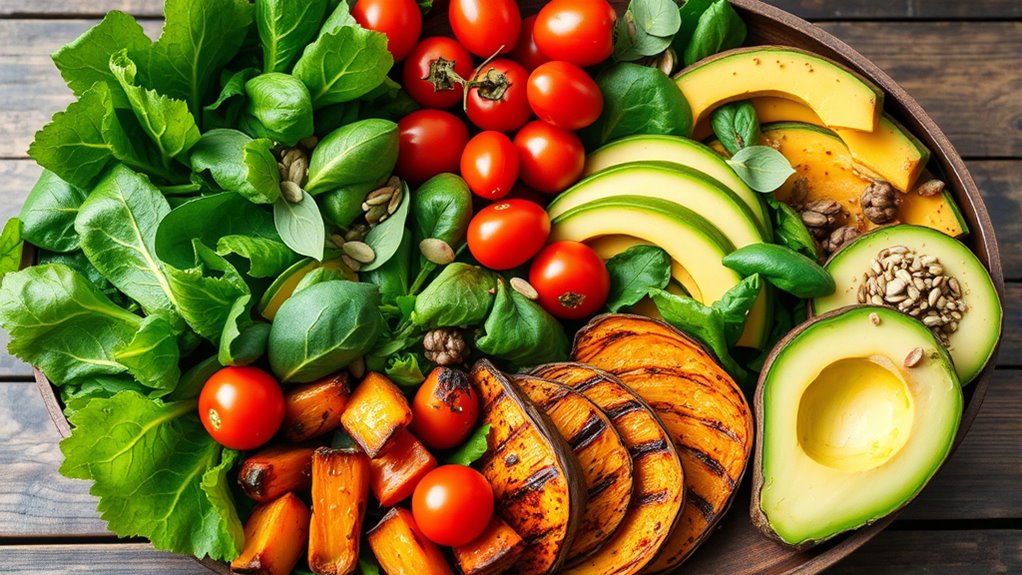To embrace plant-based eating, start by replacing one meal a day with vegetarian or vegan options, using bold herbs and spices for flavor. Explore diverse cuisines like Indian or Thai to keep meals exciting. Stock your kitchen with tofu, lentils, and superfoods like chia seeds. Many stores now offer tasty meat substitutes, and apps provide recipe ideas. Stick with it, and you’ll discover how enjoyable and beneficial a plant-based lifestyle can be; more tips and trends await you.
Key Takeaways
- Start by replacing one meal daily with vegetarian or vegan options to gradually adopt plant-based eating.
- Experiment with global cuisines like Ethiopian, Indian, and Thai for flavorful, diverse dishes.
- Incorporate superfoods such as chia seeds, spirulina, and nutritional yeast to boost nutrient intake.
- Use herbs, spices, and creative ingredients to make plant-based meals flavorful and satisfying.
- Utilize apps, online communities, and grocery store options for recipe ideas, support, and convenient meal prep.

Have you ever wondered how switching to a plant-based diet can impact your health and the environment? Making this change isn’t just about choosing different foods; it’s about adopting a lifestyle that can boost your well-being and help protect the planet.
Switching to a plant-based diet benefits your health and helps protect the environment.
When you start incorporating more plant foods into your meals, you may notice improvements in your energy levels, digestion, and overall health. Fruits, vegetables, legumes, grains, nuts, and seeds are packed with essential nutrients, fiber, and antioxidants that support your immune system and reduce inflammation.
Over time, you might find that your cholesterol levels lower, your weight stabilizes, and your risk for chronic illnesses like heart disease and type 2 diabetes diminishes. These benefits aren’t just theoretical—they’re backed by research and many personal success stories.
Switching to a plant-based diet doesn’t mean you have to give up all your favorite foods. Instead, think of it as expanding your culinary horizons. Start small by replacing one meal a day with a vegetarian or vegan option.
Experiment with flavorful plant-based recipes that use herbs, spices, and creative ingredient combinations. You’ll find that plant-based eating can be just as satisfying as your traditional meals, especially when you learn to use ingredients like lentils, tofu, tempeh, and jackfruit to mimic textures and flavors you love.
Planning ahead makes a big difference; prepping ingredients in advance allows you to whip up nutritious meals quickly, avoiding the temptation of less healthy options when you’re pressed for time.
Keeping up with current trends can also help you stay motivated. Many restaurants now feature plant-based menus, and grocery stores offer a wide array of meat substitutes and dairy-free products.
Apps and online communities can connect you with other people on similar journeys, providing recipe ideas and support. Incorporating superfoods like chia seeds, spirulina, or nutritional yeast can boost your nutrient intake and add variety to your meals.
Additionally, exploring global cuisines—Ethiopian, Indian, Thai—can introduce you to delicious, plant-forward dishes that keep your diet interesting and enjoyable. Using Eye Patch Benefits to care for the delicate skin around your eyes can also help you look more refreshed and vibrant as you focus on your overall wellness.
Frequently Asked Questions
How Can I Ensure Complete Protein Intake on a Plant-Based Diet?
To guarantee you’re getting complete protein on a plant-based diet, you should combine different plant proteins throughout the day. Focus on foods like beans, lentils, quinoa, chia seeds, and soy products.
Eating a variety of these sources helps you get all essential amino acids. You can also incorporate fortified foods or supplements if needed.
Planning your meals to include diverse protein sources guarantees you meet your nutritional needs effectively.
What Are the Common Nutritional Deficiencies in Plant-Based Eaters?
You might worry about nutritional deficiencies on a plant-based diet, but common issues include vitamin B12, iron, calcium, omega-3 fatty acids, and zinc.
To avoid these, you should include fortified foods, leafy greens, beans, nuts, seeds, and consider supplements if needed.
Regularly check your nutrient levels with your healthcare provider, and diversify your meals to cover all essential nutrients.
How Do I Dine Out While Maintaining a Plant-Based Lifestyle?
When you dine out, look for restaurants with clear plant-based options or ask staff for veggie dishes. You can customize meals by requesting extra vegetables, tofu, or legumes.
Check menus online beforehand to find suitable choices. Don’t hesitate to communicate your dietary needs; most places are accommodating.
Carry snacks or a small protein boost if options seem limited. Staying flexible keeps dining out enjoyable without compromising your plant-based lifestyle.
Are Plant-Based Diets Suitable for Athletes and Active Individuals?
Thinking about fueling your active lifestyle with a plant-based diet? It’s like harnessing the power of a thriving garden—rich in nutrients and energy.
Yes, plant-based diets can support athletes and active individuals when well-planned, providing ample protein, carbs, and healthy fats.
With smart choices like beans, nuts, seeds, and whole grains, you can perform at your best, fueling your body naturally and sustainably.
What Are Budget-Friendly Tips for Transitioning to Plant-Based Eating?
Shifting to a plant-based diet can be budget-friendly when you plan ahead. Focus on buying in-season produce, which is often cheaper, and opt for staples like beans, rice, oats, and frozen vegetables to save money.
Cooking at home instead of eating out helps control costs. Also, buy in bulk when possible and look for sales or discounts on plant-based products.
This approach makes the switch both affordable and sustainable.
Conclusion
Embracing plant-based eating paints a vibrant picture of health and harmony, where every colorful vegetable and hearty grain nurtures your body like a soothing, nourishing garden. As you savor each mindful bite, you’re cultivating a lifestyle rooted in compassion and sustainability. Let your choices blossom into a brighter, greener future—where your plate becomes a canvas of energy, and every meal plants seeds of positive change for yourself and the planet.









